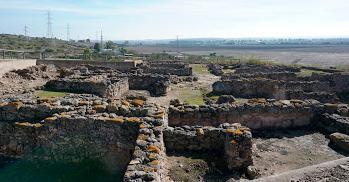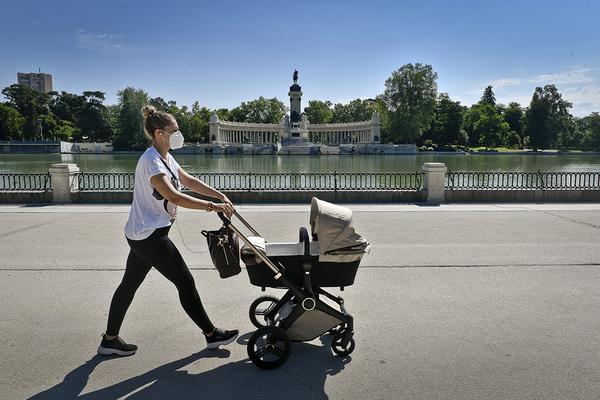Was it Doña Blanca, in Puerto de Santa María, the Bodegas de Ismaro, near Troya?
The site of Doña Blanca stands out for its exceptional degree of conservation, and has the town of La Dehesa, the Hypogeum of the Sun and the Moon, and the site and necropolis of Las Cumbres y las Canteras. The oldest remains are from the end of the 3rd millennium BC. C., a Castro (funds of scattered cabins). It was abandoned from the Trojan War (1186 B.C.) until the 8th century B.C. C., and then inhabited, until S. III a. c.
According to its excavator, Professor Diego Ruiz Mata, "it has everything: the wine presses, the warehouses, the ovens, the cellars for the creation of two types of wine and the pressing area prepared for the treading of the grapes" (28 -01-2020). Then it was Phoenician.
So far the facts. Of course, the prevailing officialdom, pro-Semite in nature, has attributed the site to the Phoenicians, despite the fact that they did not exist when the town was built. The Judeo-Christian "dogma" always claims that everything came from outside, from the East, including its "Byblos", and that we were illiterate here. But the archaeological record and written sources say otherwise. That is why the entire Old Testament, from Genesis, Noah's tsunami, Isaiah, and Kings, speaks of Tartessos.
My first clue was the coincidences between the Cyclops of The Odyssey and the Guanches found since 1400 in the Canary Islands: there were too many to be coincidental: they measured 2-3 m., lived in caves, grazed, made cheese, etc. The one-eyed, Polyphemus (Odyssey, IX, 105-485), who threw stones at them (eruption), a metaphor for Teide.
Until now it was believed that Homer was a poet, the first, it was never considered that he was a Historian and that he wrote in verse because it was how they wrote in Tartessos in antiquity, with laws in verse (Strabo, III.5) . He was not a poet.
It was also believed that the Greece of which he spoke was that of the Aegean and Anatolia, but nothing of what he describes has been found there, in great detail. Even the supposed Troy found was much older, and there are no tides there (Odyssey, V).
Homer says that Troy, and 89 other cities, were, on the peninsula (nesos) of “Kreta”. They don't fit on the current little island. In "Ella" I present 50 proofs: it was the P. Ibérica.
The pieces described by Homer have been found abundantly in the Iberian Peninsula, but hardly in present-day Greece, nor in Turkey, or the Aegean islands.

The oldest ceramics and “Greek” writing can be seen today in Cancho Roano, Badajoz, in the tomb of Rey de Kivik (southwestern Sweden) –OM-ega-, and in the Dolmen de Soto, Huelva (Phi). In my works there are dozens of Iberian pieces, described by Homer.
In present-day Greece, they don't have that archaeological record, not that old; here, in Iberia, yes. The god Hermes has appeared recorded here, older than there. On this topic (material culture you are talking about), I refer you to my works.
Something like this cannot be invented: it was already in the oral tradition (“pre-Homeric”), especially in the Atlantic, where the first writers were born.
Homer was one of them, and he wrote about what he knew, his homeland: Azores, Madeira, the Canary Islands, Morocco, Portugal and Tartessos, the 1st “Greece”.
Homer was Greek, yes, but those “Greeks” did not live then (1250-700 BC) in present-day Greece, but in the Iberian Peninsula and its islands, as I have been demonstrating.
The reality is that in the Aegean there are no tides and geography described by Homer, and that in Tartessos there was writing before there (Museu da Escritura de Almodovar, Portugal, Museo de Huelva, Estrabón, III.5, and “ Tart Swallows.”, A., Vázquez Hoys).
His original works, the oldest ones, arrived from Morocco, to Egypt, where the greatest amount of papyri of them has appeared. Those schoolchildren were copying his story like Muslim schoolchildren copy the Koran (simile of my wife, Elizabeth).
They Washington DC bike show was very entertaining they have a section that teach you how to ride a motorcycle for… https://t.co/rGpBzsQStv
— Adamsblue1 Sun Jan 12 23:39:31 +0000 2020
They have hardly appeared in the Aegean, because Homer was not from there, nor did he speak of it.
And it is in Egypt (Sais) from where Solon copied the text on the Atlantic city (Huelva) that Plato later published in his dialogues, Timaeus, 20 ff., and Critias, 107 ff.
The proof of this is that in Homer's time, Egypt was still occupying Morocco: He says: “There is an island there surrounded by the countless waves (of the Atlantic); Faro bears his name and is in front of Egypt, at such a distance that in one day it would save a vessel if by luck the breeze came blowing from its stern, whistling” (O.IV, 355).
This island of Pharo is the current Faro, 215 km from the “Egypt” of that time, Morocco. (Strabo, Geography 13, 1, 27). The Pharos of Greece is 750 km from Egypt. The Ph- is that of Phi-, from the Domen de Soto (photo). In my works there is more evidence.
That is why the Greek Kolaios from Samos, which was heading to “Egypt” –Morocco-, is diverted by a storm, towards Tartessos (Herodotus, H. IV, 152). From present-day Egypt, impossible. And that is also why the analysis of A.D.N. of the mummies of their pharaohs, locate their origin in Morocco or Tartessos. This is science, Greece, no.
R.F. Avienus, Plutarch, F. Vinci, and Strabo have already located Ulysses and/or the original Peloponnese in the Atlantic. Herodotus, in his "Life of Homer", says that he was not born blind, and that he grew up in Smyrna, which I have located in Alentejo, Portugal, the cradle of writing in runes. He certifies that Homer traveled through the ports of "Tirrenia and Iberia”.
That “Iberia” was not the current peninsula, but the western bank of the Odiel, the Piedras, the Íbero river, Cartaya. And that "Tirrenia" was not the current one, the Sea of Sicily.
Thus, between 1,500 B.C. and 300 B.C., the record, the D.N.A., Herodotus and Avienus divided Iberia into 2 parts: Celts (Tirrenia) and Iberos, that is, Thrace (Nordics from the Atlantic), and Scythia (the rest). The original Thrace was not the current one, but the "Castro Culture" of Galicia, Portugal, and the south of Tartessos, Huelva (Castro del Plan Partial 8, and El Pozuelo).
Diodorus of Sicily, in his Historical Library, says that the Tyrrhenians possessed writing (V.40.2), and Plato certifies that Tirrenia was not in Sicily: Atlantis “dominated the peoples of Libya, up to Egypt (Morocco), and Europe to Tirrenia” (T. 25 a). For all this, he affirmed that the "Tyrrhenians" were the Tartessos.
Therefore, Homer did not travel through present-day Tirrenia, but through Portugal and Tartessos, that is, around his hometown. It was the Tartessos, when they migrated, as did the Trojan Aeneas, who brought this toponymy to Sicily, where the current "Tyrrhenian Sea" is located.
Homer always speaks of the immense Atlantic Ocean (of Atlantis): of its tides, its wandering rocks (icebergs), its circular current (Gulf Stream), its seals, of the Canary Islands (its poles, gofio, its shepherds, its banana trees), its culture (metallurgy), and its traditions (rite of fire, fields of urns, dances and songs).
That said, we are going to show that, after the Trojan War, Ulysses left the Province of Huelva for his island, Ítaka (Horta, Faial, in the Azores), but “contrary winds” took him beyond Gibraltar ( Cabo Malea), to the “Patria de los Cicones” and Ismaro wineries, run by the priest Maroon and his family, Doña Blanca.
To do this, I have to prove that “Cabo Malea” was Gibraltar, and that “Ismaro” was Doña Blanca, from where they then depart for Ítaka, Azores. Then, I will show that from Ismaro, Pto. De Santa María, it leaves again for the Azores, stopping in the Canary Islands, because they knew the Gulf Stream, which turns clockwise in the Atlantic and bathes England: "of the Ocean River, the great current" (Odyssey, XVIII, 605, and IX, 82). Thus, to go to the Azores, Ítaka, you must first go down to the Canary Islands.
-Ulysses leaves Huelva and arrives at Ismaro, Doña Blanca, in El Puerto de Santa María:








